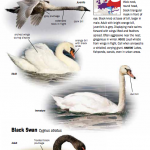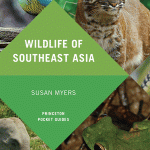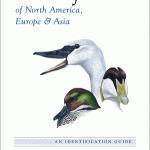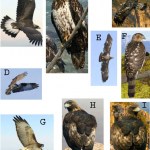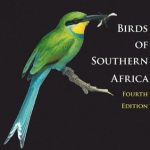field guide
Over the years, the field guide and the coffee table book have merged, and we now have coffee table-ish books (but serious books) that include a species description of every critter in a certain clade. In the case of Horses of the World by Élise Rousseau (Author), Yann Le Bris (Illustrator), Teresa Lavender Fagan (Translator), while every living species of horse is in fact covered, the book is a comprehensive guide to breeds of horses.
Of which there are 570.
A horse is horse, of course, but but is a donkey or an ass? What about zebras?
Horse people are very picky about what they call a…
A Swift Guide to Butterflies of North America is a field guider's field guide. It is the shape and size of a traditional field guide. The designers of this book said "we don't need no stinking margins" so there are no margins. Color bleeds on the page edges allow a quick index to major butterfly categories. There is a two page spread visual index. A no nonsense introduction give you the basics about how to use the book, how to be a butterflyer, and how to not be a jerk about butterflies (like, don't net them and kill them). The front covers even have those flaps that you can use as…
Just got my copy of Birds of Europe, North Africa, and the Middle East: A Photographic Guide by Frédéric Jiguet and Aurélien Audevard.
This is the first and only field-ready photographic bird guide that covers every species in Europe. There are 2,200 photos covering 860 species. The West Asian and North African coverage is of all of the species there that have occurred in Europe, so think of this primarily as a European guide.
The entry for the Mute Swan.
I hasten to add and emphasize. These are not your grandaddy's photographs. Many photographic guides have pretty nice looking…
How do you judge a field guide?
Phillipps' Field Guide to the Mammals of Borneo and Their Ecology: Sabah, Sarawak, Brunei, and KalimantanSome field guides you leave on the shelf and rarely look at. Others you may put in the living room to spice up the coffee table, because they make great eye candy, but are otherwise not that useful. Others you take out, and at least have around in case you need them. Others you make sure you are never very far away from because you find yourself looking for them all the time.
And, every once in a while, a field guide comes along that you want to take to…
Wildlife of Southeast Asia by Susan Myers, is a new pocket identification guide covering "wildlife" in Burma, Thailand, Laos, Cambodia, Vietnam, West Malaysia, and Singapore.
It covers birds, mammals, reptiles, frogs, and invertebrates. Considering that there must be tens of millions of inverts in Southeast Asia, the coverage here is very minimal, just the highlights, just a few pages. This is mainly a bird book, with pretty good coverage of mammals, a bunch of snakes, some of the more important frogs, and some of the more obvious insects, etc.
It is standard field guide size, and uses…
According to the Encyclopedia Britannica, there are 143 species of bovids. The Animal Diversity Web is a bit less precise, indicating that there are "more than 140 extant and 300 extinct species." That second number is highly questionable because today there exist sister species that are so similar I doubt they could be told apart from fossils alone. If you check around the internet, this ~140 number comes up again and again, and Wikipedia says 143.
Research published in 2011 and later by Colin Groves, Peter Grubb, and David Leslie, which has been tagged as controversial by some but…
There are three kinds of books that count as animal (usually bird) guides.
1) A pocket field guide of the critters of a reasonably circumscribed geographical area, like the Peterson Field Guide to Birds of Eastern and Central North America. This is a small book that can fit in a big pocket, and a classic guide like this one is something you'll want to have with you while bird watching in the eastern or central US.
2) A big book, not suitable for pockets, of the critters of a reasonably circumscribed geographical area. A great example of this is The Crossley ID Guide: Eastern Birds . It…
Wildlife of the Galápagos: Second Edition (Princeton Pocket Guides), by Julian Fitter, Daniel Fitter, and David Hosking is both a field guide and a travel guide, focusing on the Galapagos Islands. It includes basic information about each island and each town or tourist destination, and a comprehensive guide to how to visit, what to bring and not bring, and otherwise plan your trip to these amazing evolution-drenched islands.
The wildlife that is covered includes birds, other land vertebrates including the famous tortoises and lizards, offshore mammals, fish, insects, and plants. There is…
You’ve heard of the The Crossley ID Guide: Eastern Birds (The Crossley ID Guides). It is a revolutionary new way to assemble a field guide, where each page has a drawing of what it would look like if suddenly outside your living room there was a full blown habitat for some species of bird, with individuals from that species flying or sitting all over the place in different positions, doing different things, and at different distances. These pages in the field guide almost give you the experience of having seen many of this partiuclar species of bird, like you were suddenly an experienced…
When traveling and working in South Africa, I've always used Newman's guide to the birds of Southern Africa, and more recently, I found the Sasol guide to be helpful as well. (I discuss both briefly here.) Now, I've got on my desk a copy of Princeton's Birds of Southern Africa: Fourth Edition by Ian Sinclair, Phil Hockey, Warwick Tarboton and Peter Ryan. You will know Sinclair from his South of the Saraha bird guide.
All three books cover about the same species, as far as I can tell (just under 1,000) and have a similar range of illustration and information. They all have overview…
Wildlife of Southern Africa , by Martin Withers and David Hosking, is new (August 2011) and good. If you are planning a trip to South Africa, Namibia, Botswana or anywhere nearby, or if you live there and like to go to the bush sometimes, consider it.
This is a pocket guide, it is small, has good photographs, is inexpensive, and accurate.
In my opinion, if you are travelling around Africa looking at wildlife, you will need a set of more specialized guides (which I've discussed at length elsewhere on this blog, see below), but this is a good extra to carry along or to have handy, depending…
Why would you want a field guide to all of the carninvores? They live everywhere, so there is no reason to carry around a field identification guide with ALL of them unless you were going everywhere in the whole world on one trip!
Yet, there is such a field guide, Carnivores of the World (Princeton Field Guides), and the truth is, this is ONE OF THE COOLEST BOOKS I'VE EVER SEEN! All the carnivores (almost) in one book. Interestingly, it turns out to be possible. There are fewer than three hundred species of terrestrial carnivore in the whole world, and that is fittable in a single book…
Face it. Half the time ... most of the time, really ... you use your Peterson (or some other favorite "field guide") as a checklist. You see a bird and you pretty much know in your head what it is, but you need to look it up to see what the three or four similar ducks or woodpeckers or whatever are in your area in order to be sure that it is a Common Merganser or a Red Headed Woodpecker or whatever. All you need is a basic picture (drawing preferred for this sort of thing) the names of the birds and basic range maps.
That is the role played by the Princeton Illustrated Checklists; These…
tags: birding, bird books, Bird Field Guide, The Young Birder's Guide to Birds of Eastern North America, Bill Thompson III, book review
One of the most common questions that I am asked is "how can we get our internet- and video game-addicted kids interested in the out-of-doors?" Since I am an internet-addicted semi-adult, I can say that one way to get kids interested in nature is to make it accessible to them, and perhaps the best way to do this is through books. A new field guide was just published whose target audience is kids between the ages of 8 and 12 years old. This remarkable book,…
tags: Field Guide to the Natural World of New York City, nature, field guide, NYC, Leslie Day, Mark Klingler, book review
What do you think of when you heard the words, "New York City"? Money? Skyscrapers? Broadway plays? Restaurants? Millions of people living in tiny apartments? Fire hydrants spurting water on hot muggy days? Rotting garbage on the sidewalks? How about birds: do any of you think of birds and other wildlife? Most people don't. Many people, especially visitors, are unaware of the wealth of green spaces and parks in NYC, along with their resident and migratory wildlife. However…


